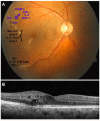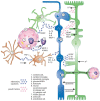Role of Inflammation in Diabetic Retinopathy
- PMID: 29565290
- PMCID: PMC5979417
- DOI: 10.3390/ijms19040942
Role of Inflammation in Diabetic Retinopathy
Abstract
Diabetic retinopathy is a common complication of diabetes and remains the leading cause of blindness among the working-age population. For decades, diabetic retinopathy was considered only a microvascular complication, but the retinal microvasculature is intimately associated with and governed by neurons and glia, which are affected even prior to clinically detectable vascular lesions. While progress has been made to improve the vascular alterations, there is still no treatment to counteract the early neuro-glial perturbations in diabetic retinopathy. Diabetes is a complex metabolic disorder, characterized by chronic hyperglycemia along with dyslipidemia, hypoinsulinemia and hypertension. Increasing evidence points to inflammation as one key player in diabetes-associated retinal perturbations, however, the exact underlying molecular mechanisms are not yet fully understood. Interlinked molecular pathways, such as oxidative stress, formation of advanced glycation end-products and increased expression of vascular endothelial growth factor have received a lot of attention as they all contribute to the inflammatory response. In the current review, we focus on the involvement of inflammation in the pathophysiology of diabetic retinopathy with special emphasis on the functional relationships between glial cells and neurons. Finally, we summarize recent advances using novel targets to inhibit inflammation in diabetic retinopathy.
Keywords: Müller glial cells; astrocytes; crystallins; diabetic retinopathy; inflammation; microglia; neurodegeneration; neuroprotection; pathophysiology.
Conflict of interest statement
The authors declare no conflict of interest.
Figures



References
-
- Kempen J.H., O’Colmain B.J., Leske M.C., Haffner S.M., Klein R., Moss S.E., Taylor H.R., Hamman R.F., Eye Diseases Prevalence Research Group The prevalence of diabetic retinopathy among adults in the United States. Arch. Ophthalmol. 2004;122:552–563. - PubMed
-
- AAO PPP Retina/Vitreous Panel, Hoskins Center for Quality Eye Care. [(accessed on 30 October 2017)];Diabetic Retinopathy Ppp—Updated. 2016 Available online: http://www.aao.org/preferred-practice-pattern/diabetic-retinopathy-ppp--....
Publication types
MeSH terms
Grants and funding
LinkOut - more resources
Full Text Sources
Other Literature Sources
Medical
Molecular Biology Databases

